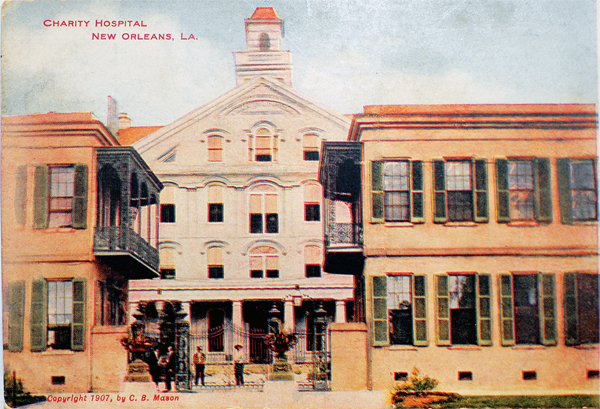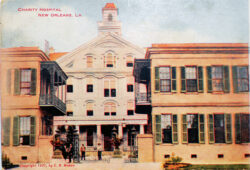Public Works Administration Architecture
The Public Works Administration projects in Louisiana during the Great Depression include numerous courthouses, university buildings, and Charity Hospital in New Orleans.

Courtesy of The Historic New Orleans Collection
Charity Hospital. Weiss, Dreyfous, Seiferth (Architects)
As the Great Depression gripped the country—putting 25 percent of the labor force out of work, driving farmers off their land, paralyzing investment, and forcing banks out of business—Franklin D. Roosevelt was elected president to deal with these multiple calamities. The New Deal, a collection of programs implemented by Roosevelt, included a variety of public works agencies designed to employ the jobless, stimulate the economy, and build the facilities that communities needed. The Public Works Administration (PWA) was one of the first agencies. These programs produced a massive amount of our physical and cultural infrastructure, much of which we are still using three-quarters of a century later. The impact of the PWA on Louisiana architecture was tremendous.
Established in June 1933, the PWA’s mission was to build large-scale projects: dams, bridges, courthouses, hospitals, university buildings, and schools, among other things. Because this required planning, machinery, and skilled labor, the PWA started slowly and, at first, did not have a great impact on unemployment. Thus, several other public works programs were created, including the Civil Works Administration (which lasted only four and a half months during the winter of 1933–1934), and later the Works Progress Administration (WPA), which began in 1935 and lasted until 1943. These programs concentrated on labor-intensive projects, employing unskilled workers as well as professionals and artists. The WPA is often confused with the PWA, but it was always a separate organization with its own leadership, organization, procedures, and goals.
PWA Projects
Proposals for PWA projects originated at the local level. A community decided what it wanted and hired a local architect or engineer to design it. Although the PWA did not tell communities what they should want or how a structure should look, proposals were reviewed in Washington for structural, legal, and fiscal soundness. Most proposals were read by the president himself. If approved, funding was shared: 30 percent came from the PWA; the remaining 70 percent was provided by the sponsors. If they could not come up with the money, the PWA loaned it to them. In 1935, the split became 45 percent from the PWA and 55 percent from the sponsors. By that time, bond markets had recovered and most communities were able to sell bonds, which had to be approved in a local election. There were very few defaults on PWA loans, and interest from them went into a revolving fund to provide more grants.
Once approved, the projects were executed by local contractors using local labor. A resident engineer-inspector guarded against fraud, waste, or poor construction, and an investigation division in Washington sent its agents to the site in response to any complaint of impropriety. Thus, most questionable conduct was stopped before it got very far, and scandals never besmirched the PWA’s reputation. Its administrator, Secretary of the Interior Harold L. Ickes, was known as “Honest Harold.”
Because the architectural style of the project was determined by local taste, there is no standard way to recognize a PWA project. There was, however, a style popular with architects at the time, which featured a combination of a classical facade, simplified columns and entablature, and Art Deco details, that is sometimes referred to as PWA Moderne. Many of the PWA courthouses in Louisiana were built in this style.
PWA Projects in Louisiana
Eleven Louisiana parishes got new courthouses, six received additions, and three had repairs. More courthouses were built between 1936 and 1940 than in any other period in the history of the state. The new buildings, all extant, are in Caldwell, Cameron, East Carroll, Iberia, Jackson, Madison, Natchitoches, Rapides, St. Bernard, St. Landry, and Terrebonne parishes. The Cameron Parish courthouse survived two hurricanes: Hurricane Audrey in 1957 and Hurricane Rita in 2005.
Higher education was well established in Louisiana before the New Deal but was centered in Baton Rouge and New Orleans. Louisiana State University (LSU) and Southern University gained PWA-funded buildings. LSU’s campus was enlarged by the geology building, Himes Hall, the faculty club, three women’s dormitories, and the Audubon Sugar Factory. Southern University’s campus grew with Mumford Stadium, Bradford Hall, Grandison Hall, a gym/auditorium, and two other dormitories that have not survived. But this was token work compared with the blossoming of the fledgling regional universities. Two buildings in Monroe, three in Lake Charles, five plus a water tower in Grambling, seven each at Hammond and Louisiana Tech in Ruston, eight plus additions in Natchitoches, and twelve at Lafayette replaced makeshift and ill-equipped facilities. These campuses greatly extended the reach of higher education in the state.
High schools and elementary schools sprouted around the state as well, some costing hundreds of thousands of dollars. They offered facilities such as science laboratories, music rooms, vocational education shops, home economics “cottages,” and combination gymnasium-auditoriums that previously were unimaginable. Though white students usually got larger and more expensive facilities, many new schools for African Americans were built well, many of which survive today. As demographics have changed, some of these buildings are no longer needed as schools, but several have found new use as apartment and condominium complexes.
Many state landmarks owe their existence to the PWA: the Louisiana State Exhibit Building (now known as the Louisiana State Museum) in Shreveport, the Capitol Annex in Baton Rouge, Charity Hospital, buildings for the Gillis W. Long Hansen’s Disease Center at Carville, and the Huey P. Long Bridge. The French Market in New Orleans existed before the New Deal, but the PWA’s efforts to preserve what was salvageable, construct reinforcements, and aesthetically integrate the structure into the site are largely responsible for its appearance today. The municipal incinerator in Shreveport (now demolished) was a landmark of international reputation during its lifetime because of its modernist architecture.
Though created initially to fight the Great Depression, the PWA has made an incalculable contribution to the civic, educational, cultural, and economic development, as well as the architectural heritage, of Louisiana. Its benefits are still being enjoyed.
